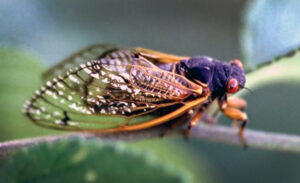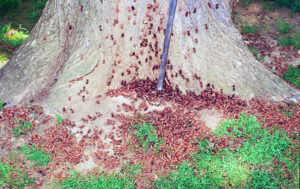By Michael Hillstrom, Forest Health Specialist, Fitchburg;
Michael.Hillstrom@wisconsin.gov

Closeup of a periodical cicada, showing its black body and orange-colored wing veins and legs. / Photo Credit: Ward Upham, Kansas State University, Bugwood.org
2024 will be a big year for periodical cicadas (Magicicada spp.).
For the first time since 1803 — when Thomas Jefferson was president — 13-year Brood XIX and 17-year Brood XIII cicadas will co-emerge in the millions.
If you want to observe this spectacle, you can see the Brood XIII cicadas in southern Wisconsin. Expect to see and hear them in June, and bring your ear protection because some of the louder choruses of males can reach 90 decibels.
Unfortunately, Brood XIX does not occur in Wisconsin. Central Illinois is the closest location to see those cicadas.
We see the large, non-periodical, dog-day cicadas (Neotibicen spp.) with green wing veins in Wisconsin in late summer every year. But the smaller periodical cicadas with orange wing veins only emerge every 13 or 17 years. The nymphs are underground, feeding on roots for all those years between emergences. Adult periodicals only live a few weeks – long enough to mate and lay eggs to begin the cycle anew.
Cicadas do not sting or bite and are a valuable food source for wildlife. Cicada feeding does not generally injure plants, but damage does occur when females cut slits in twigs to lay eggs. Females prefer to lay eggs in pencil-diameter twigs. You may notice twig dieback in larger trees, but this damage is generally not detrimental to the tree. Damage to saplings may be more severe and require corrective pruning.

Empty cicada larval cases surround a tree trunk during a 2004 outbreak of Brood X. / Photo Credit: Jim Occi, BugPics, Bugwood.org
If susceptible young trees or shrubs need to be protected, cover them with bird netting or similar. Pesticide application is not practical or advised outside of tree nurseries, fruit tree farms or vineyards.
Learn more on the University of Connecticut Broods webpage, or join the fun and report your cicada sightings via the Cicada Safari app.
